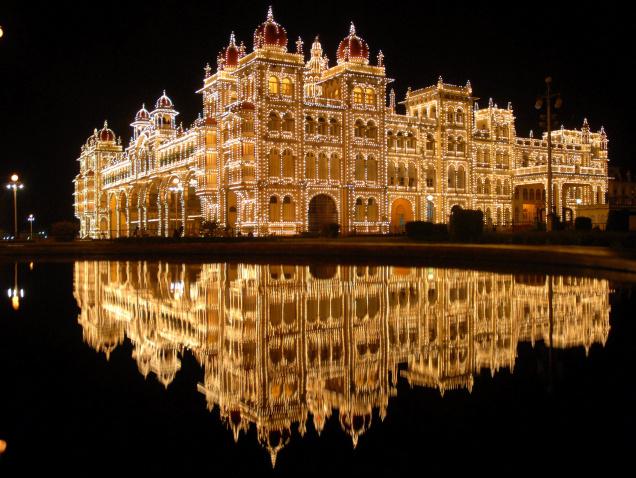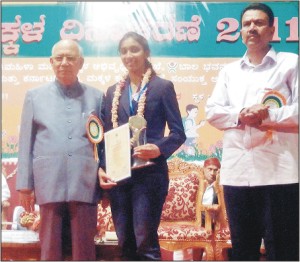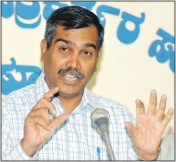| Karnataka, which has been in the forefront for some years now, expectedly ruled the pool by emerging the overall champion. It also won the men’s and women’s team championships. Over to S. Sabanayakan. |
MANOB CHOWDHURY

Aaron D’Souza in the 200m breast stroke event. The Karnataka swimmer won five gold medals and set three records. He was adjudged the Best Swimmer of the Meet.
As the curtain came down on the 65th National Championships at the Veer Budhu Bhagat Aquatic Stadium in Ranchi, the purpose of organising such an important meet was largely met thanks to some stirring performances by the country’s top swimmers.
The five-day meet, held in excellent conditions, proved to be a big success, especially considering the fact that the capital of Jharkhand was hosting its first swimming Nationals. Four National records and 15 meet records were set in swimming while one meet mark fell in diving, which was a rare occurrence particularly since the discipline has never caught the imagination of the aficionados of the sport in the country.
The fact that the meet was the final event of the SFI (Swimming Federation of India) calendar this year did not in anyway affect the performance of the participants.
There was no doubt as to who would dominate the meet. Karnataka, which has been in the forefront for some years now, expectedly ruled the pool by emerging the overall champion. It also won the men’s and women’s team championships. Maharashtra finished second in the overall standings, followed by Railways and Tamil Nadu.
The Railway divers were in complete control as they won the team championships in both the men’s and women’s sections.
The two stars of the meet were Aaron D’Souza of Karnataka and Richa Mishra of Police. The duo walked away with the ‘Best Swimmer of the Meet’ awards. Both won five individual gold medals and set three records each.
Of the three records that Richa broke, one was a National mark (400m freestyle).
The talking point of the meet though was D’Souza who finished within the Olympic invitation qualifying time of 1:51.59s in the 200m freestyle. He stunned the sparse gathering by clocking 1:51.38s. The effort proved to be in vain for the 19-year-old Bangalore collegian as the championship was not one of the qualifying meets recognised by the world swimming body, FINA.
Nevertheless D’Souza showed that he was capable of attaining the Olympic qualifying time. Only two Indian swimmers, Veerdhawal Khade and Sandeep Sejwal, have qualified for the London Games.
Another youngster who made a big splash was Saurabh Sangvekar, also of Karnataka. The 17-year-old, who relishes the 1500m, 800m and 400m freestyle events, posted personal best times in winning gold medals. The gangling boy, who was born in Thane, near Mumbai, but lives in Bangalore to get quality coaching, made rapid strides to achieve the twin records. Possessing a calm persona, Sangvekar will be aiming to make it to the London Olympics. His 15:51.10s in the 1500m freestyle was nearly eight seconds off the Olympics qualifying time of 15:43.74.
“In the last five months, he managed to shave off eight to nine seconds over the distance and I expect him to attain the required time much before the London Games,” said the National coach, Pradeep Kumar.
Sandeep Sejwal of Railways too made a terrific impact by winning three gold medals, all with record times, and a silver medal. The 22-year-old, who trains under Nihar Amin in Bangalore, achieved the Olympic invitation qualifying mark (1:02.92) in the 100m breaststroke event with a time of 1:02.62 at the FINA Worlds earlier this year. He put up a far better performance here, clocking 1:01.97s. The effort only underlined Sejwal’s dedication and determination.
PTI

Richa Mishra with the five gold medals she won at the Nationals. She also won the ‘Best Swimmer of the Meet’ award.
Despite dominating the women’s category, Karnataka was yet to find a swimmer who could challenge the supremacy of Richa Mishra, the reigning queen of Indian swimming. The 27-year-old CRPF inspector has, over the years, been in complete control of her events barring the odd defeat that she suffered in Jaipur last year.
The Karnataka swimmers found out much to their chagrin that winning medals by the dozen was one thing, but conquering Richa another.
Among the young talent on view the most outstanding was A. V. Jayaveena of Tamil Nadu. The petite girl, daughter of a noted Tamil actor Vijayakumar, came into the limelight when she was only 13 years old during the 34th National Games held in Ranchi. She went one step ahead at the Nationals here to emerge the fastest breaststroker. Jayaveena won the 50m breaststroke event in a meet record time.
Tamil Nadu also had another talented swimmer, M. Raghavi, who won two gold medals in the 100m and 200m breaststroke events. The 17-year-old won a hat-trick of gold medals in the 200m event and picked up the 100m gold for the first time.
Tamil Nadu, thanks to its excellent junior development programme, is a State to watch out for in the near future.
The decline of Maharashtra in the senior section was a cause for concern indeed. Like Bengal, Maharashtra had ruled Indian swimming at one time. Lack of proper coaching and infrastructure might have forced many a talented swimmer to shift base to Karnataka, but there’s no denying the fact that Maharashtra still has plenty of talent.
Aditi Dhumatkar is one such swimmer who would make Maharashtra proud in the days to come. The present crop of sub-junior swimmers would certainly help Maharashtra regain its past glory.
However, for Bengal there is no such hope as the state federation is torn by factional feud. Just one medal in the men’s section (a bronze in relay), three bronze medals in diving and a fourth place finish in women’s waterpolo is a poor reflection of Bengal that had not very long ago produced swimmers of the calibre of Bula Chowdhury among others.
MANOB CHOWDHURY

Saurabh Sangvekar of Karnataka in action in the men’s 1500m freestyle. The 17-year-old set National records in the 1500m, 800m and 400m freestyle events.
The emergence of Anshul Kothari from Gujarat, the fastest man of the meet, and the presence of Talasha Prabhu of Goa, the fastest woman of the championship, only highlighted the efforts of individuals from these States.
One of the biggest employers of sportspersons in India, the Railways, almost seemed to recover from the slump it has suffered in recent years. It was expecting to take the men’s team title but was overwhelmed by Karnataka. According to a prominent coach the public sector major needs to offer a better package in order to attract the best of talent in the country.
In diving Hrutika Shriram of Railways has been winning the three events — highboard, 3m and 1m springboard — since 2005. That she managed to improve upon her own 1m springboard record of 202.95 points set in 2006 with an effort of 212.15 points only highlighted the lack of attention to this most neglected event.
“Diving is a precision event and coaching support is very vital,” said Hrutika. “Divers need better coaching, infrastructure and practice facilities,” she added.
GOLD MEDAL WINNERS
Men — 50m freestyle: Anshul Kothari (Gujarat) 24.08s. 100m freestyle: Aaron D’Souza (Karnataka) 51.15s (NMR; Old: 51.43s by D’Souza, 2009). 200m freestyle: Aaron D’Souza 1:51.38s (NMR; Old: 1:53.36 by D’Souza, 2009). 400m freestyle: Saurabh Sangvekar (Karnataka) 4:01.35s (NR; Old: 4:01.83s by Rehan Poncha, 2009). 800m freestyle: Saurabh Sangvekar 8:12.57s (NR; Old: 8:23.08 by Mandar Divese, 2009). 1500m freestyle: Saurabh Sangvekar 15:51.10s (NR; Old: 15:56.96s by Mandar Divase, 2009) 50m backstroke: Aaron D’Souza 27.23s (NMR; Old: 27.46s by M. B. Balakrishnan, 2010). 100m backstroke: Rohit R. Havaldar (Karnataka) 1:00.48s. 200m backstroke: Rehan Poncha (Karnataka) 2:07.85s. 50m breaststroke: Sandeep Sejwal (Railways) 28.35s (NMR; Old: 28.93 by Sejwal, 2011). 100m breaststroke: Sandeep Sejwal 1:01.97s (NMR; Old: 1:04.26 by Sejwal, 2009). 200m breaststroke: Sandeep Sejwal 2:16.37s (NMR; Old: 2:17.92 by Sejwal, 2010). 50m butterfly: Sarma S. P. Nair (Railways) 26.13s. 100m butterfly: Aaron D’Souza 56.02s. 200m butterfly: Aaron D’Souza 2:02.22s. 200m individual medley: Rehan Poncha 2:07.95s. 400m individual medley: Rehan Poncha 4:35.59s. 4x100m freestyle relay: Karnataka 3:34.55s (NMR; Old: 3:37.63s by Karnataka, 2009). 4x200m freestyle relay: Karnataka 7:58.36s (NMR; Old 8:02.56s by Karnataka, 2010). 4x100m medley relay: Railways 3:56.06s (NMR; Old: 3:56.98 by Railways, 2010).
Women — 50m freestyle: Talasha Prabhu (Goa) 27.52s. 100m freestyle: Surabhi Tipre (Karnataka) 1:00.28s. 200m freestyle: Richa Mishra (Police) 2:07.29s (NMR; Old: 2:07.92 by Nisha Millet, 2003). 400m freestyle: Richa Mishra 4:25.76s (NMR; Old: 4:28.97s by Richa, 2009). 800m freestyle: Richa Mishra 9:06.31s (NR; Old: 9:10.96s by Richa, 2010). 1500m freestyle: Surabhi Tipre 17:46.38s (NMR; Old: 18:00.64s by Richa Mishra, 2007). 50m backstroke: Fariha Zaman (Karnataka) 32.13s. 100m backstroke: Arti Ghorpade (Maharashtra) 1:08.75s. 200m backstroke: Arti Ghorpade 2:28.59s. 50m breaststroke: A. V. Jayaveena (TN) 35.48s (NMR; Old: 35.63 by Saba Sait, 2004). 100m breaststroke: M. Raghavi (TN) 1:18.55s (NMR; Old: 1:18.66 by V. Tejaswini, 2006). 200m breaststroke: M. Raghavi 2:48.39s. 50m butterfly: Pooja R. Alva (Karnataka) 29.56s. 100m butterfly: Pooja R. Alva 1:04.20s. 200m butterfly: Pooja R. Alva 2:22.28s. 200m individual medley: Richa Mishra 2:25.33s. 400m individual medley: Richa Mishra 5:05.17s. 4x100m freestyle relay: Karnataka 4:08.96s. 4x200m freestyle relay: Karnataka 9:04.80s. 4x100m medley relay: Karnataka 4:36.37s (NMR; Old: 4:39.62, 2009).
DIVING
Men — Highboard: Tushar Gitaye (Railways) 325.85 points. 3m springboard: Ramanand Sharma (Maharashtra) 322.85 points. 1m springboard: T. Hariprasad (Railways) 286.95 points.
Women — highboard: Hrutika Shriram (Railways) 233.55 points. 3m springboard: Hrutika Shriram 215.10 points. 1m springboard: Hrutika Shriram 212.15 points (NMR; Old: 202.95 by Hrutika, 2008).
WATERPOLO
Men’s champion: Services; Women’s champion: Kerala.
Best swimmer: Aaron D’Souza (men); Richa Mishra (women).
TEAM CHAMPIONSHIP
Swimming — Men: Karnataka (164 points); Women: Karnataka (163 points).
OVERALL CHAMPION
1. Karnataka (327 points), 2. Maharashtra (176), 3. Railways (143).
TEAM CHAMPIONSHIP
Diving — Men: Railways (30 points); Women: Railways (26).
source: http://www.tssonnet.com / Aquatics> National Championship / SPORTSTAR vol.36, no.49, Dec 08th, 2011





